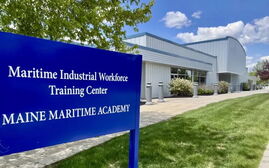
BIW's latest destroyer gets Navy's OK after sea trials
A crew with General Dynamics Bath Iron Works successfully demonstrated the operational capability of the latest destroyer commissioned by the U.S. Navy.
The John Basilone (DDG 122) completed acceptance trials last week with an operating crew demonstrating a number of ship systems for the Navy’s Board of Inspection and Survey over two days in the Gulf of Maine.
“John Basilone is a remarkable ship that embodies the skill and dedication of the thousands of shipbuilders who created it,” said Charles Krugh, BIW’s president.
During acceptance trials, a Bath Iron Works crew operates the ship and demonstrates its hull, mechanical and electrical systems perform as expected. The Navy team determines whether the ship’s systems are operational prior to the Navy taking delivery.

“DDG” is a hull designation that signifies a ship is a guided missile destroyer.
Arleigh Burke class
Since 1902, there have been 10 classes of U.S. Navy destroyers, according to the Navy’s Naval History and Heritage Command Communication and Outreach Division.
The first was commissioned in 1902. Since then, the warships have “evolved from small, fast, close-in surface combatants to multi-mission offensive and defensive warships that can operate independently or as part of strike groups.”
The John Basilone is one of a number of destroyers that, together, are called the Arleigh Burke class.
The class is named after the USS Arleigh Burke, a 505-foot ship commissioned in 1991. The class of ships is considered the workhorse of the Navy's fleet. It was the Navy's first class designed with shaping techniques to reduce the ships' radar cross-section, improving the likelihood of not being targeted by enemy weapons and sensors.
The Arleigh Burkes have been a staple of BIW’s shipbuilding for decades.
The John Basilone is named for Medal of Honor recipient Gunnery Sgt. John Basilone, a hero in the defense of Henderson Field in Guadalcanal in World War II and recipient of the Navy Cross for bravery at Iwo Jima.
Bath Iron Works has other Arleigh Burke-class destroyers under construction: the Harvey C. Barnum Jr. (DDG 124) and Patrick Gallagher (DDG 127) as well as the Flight III configuration destroyers Louis H. Wilson Jr. (DDG 126), William Charette (DDG 130), Quentin Walsh (DDG 132) and John E. Kilmer (DDG 134).
It began construction of the USS John E. Kilmer last fall.
The Flight III design variant is centered on an air and missile defense radar system, and are considered the most technologically advanced surface warships in the world, the company said in a news release.
Major employer
BIW is owned by Reston, Va.-based General Dynamics Corp. (NYSE: GD) and has 6,600 employees.
Established in 1884, BIW is one of the largest private sector employers in Maine.
From 2017 through 2021, BIW operations supported more than $8.4 billion in total economic activity in Maine, according to a report published in 2022 by the University of Southern Maine’s Center for Business and Economic Research.
Including multiplier effects, BIW supported more than $1.8 billion in total economic output in 2021 alone, with more than $980 million contributing to the state’s gross domestic product.
BIW hired a total of 6,363 workers between 2016 and 2021, averaging more than 1,000 new workers per year. Most new hires were concentrated in the years 2019 and 2021, which experienced the largest recruitments of more than 1,800 in each of those years.
For three core entry-level occupations analyzed, workers advanced quickly over a five-year period, increasing annual earnings of approximately $33,000 upon entry to approximately $60,000, an 80% increase in pay.













0 Comments